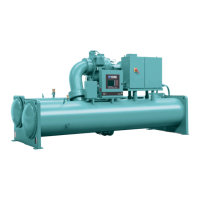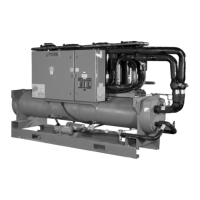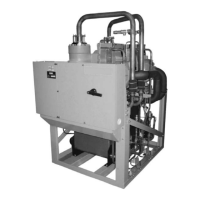FOF. For older units where they are not seen on the FOF, they would be provided upon request
from the chillers sales engineer from the chiller rating program. These depend on tube selection,
chilled fluid type, operating head, and operating condition. The following equations define these
parameters. Condenser level/Sub-cooling is detected by the liquid level sensor and controlled to
the programmed set-point by the chiller control logic.
Equations:
• Evaporator approach = (LCHLT) - (EST)
• Discharge superheat = (CDT) - (CST)
Definitions, based on the OptiView panel operation data:
• EST = Evaporator saturation temperature
• LCHLT = Leaving evaporator liquid temperature
• CDT = Compressor discharge temperature
• CST = Condenser saturation temperature
The parameters can be viewed on the OptiView control center. The chiller must be at full load
design operating conditions so that the correct refrigerant charge level can be correctly determined
when operating. When the correct condenser level is set to maintain the design sub-cooling, the
evaporator approach and discharge superheat are a function of the amount of charge that are now
maintained in the evaporator. To lower evaporator STD and compressor discharge superheat, the
refrigerant charge is added to the system. If greater details are needed, contact product technical
support (PTS) for guidance.
Checking the refrigerant charge unit during shutdown
The refrigerant charge is specified for each chiller model. Charge the correct amount of refrigerant
and record the level in the evaporator sight glass. This is only an effective method if the chiller is a
flooded evaporator and has been idle at normal ambient conditions for greater than 24 hours. If
there has been water flow in either circuit in that time, this not a valid method.
The refrigerant charge level must be checked after the pressure and temperature have equalized
between the condenser and evaporator. This may be 24 hours or more after the compressor and
water pumps are stopped. The level is visible in the sight glass.
Trimming can only be performed when the chiller is operational using design operating criteria to
evaluate the charge amount.
Charge the refrigerant in accordance with the method described in Checking and trimming
the refrigerant charge. Observe the refrigerant level and record the level recorded after initial
charging.
Handling refrigerant for dismantling and repairs
If it becomes necessary to open any part of the refrigerant system for repairs, it is necessary to
remove the charge before opening any part of the unit. If the chiller is equipped with optional
valves, the refrigerant can be isolated in either the condenser or evaporator and compressor while
making any necessary repairs.
Compressor and motor maintenance
1. Check mounting screws and piping joint nuts frequently to insure tightness.
2. Test motor windings annually to check for deterioration of windings.
Electrical test of motor winding resistance should be performed by a qualified service
technician according to Service Instructions Manual (Form 160.84-M1) because it involves
determination of power leads between the motor and the VSD. Results from these winding
insulation resistance tests should be trended each interval to determine degradation in
motor windings.
YMC
2
Mod B with OptiView Control Center
156

